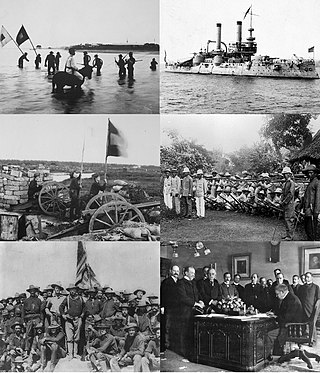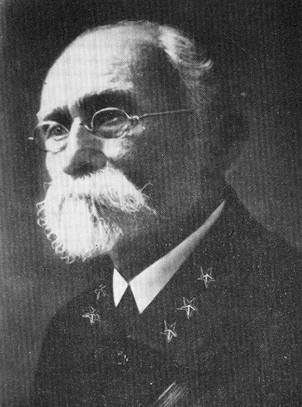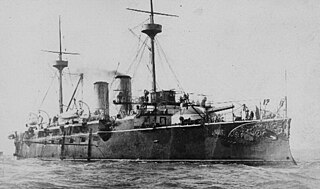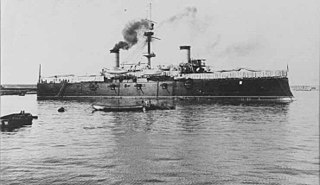
The Spanish–American War was fought between Spain and the United States in 1898. It began with the sinking of the USS Maine in Havana Harbor in Cuba, and resulted in the U.S. acquiring sovereignty over Puerto Rico, Guam, and the Philippines, and a protectorate of Cuba. It represented U.S. intervention in the Cuban War of Independence and Philippine Revolution, with the latter later leading to the Philippine–American War. The Spanish–American War brought an end to almost four centuries of Spanish presence in the Americas, Asia, and the Pacific; the United States meanwhile not only became a major world power, but also gained several island possessions spanning the globe, which provoked rancorous debate over the wisdom of expansionism.
Santiago is the capital city of Chile.

The Battle of Santiago de Cuba was a decisive naval engagement that occurred on July 3, 1898 between an American fleet, led by William T. Sampson and Winfield Scott Schley, against a Spanish fleet led by Pascual Cervera y Topete, which occurred during the Spanish–American War. The significantly more powerful US Navy squadron, consisting of four battleships and two armored cruisers, decisively defeated an outgunned squadron of the Royal Spanish Navy, consisting of four armored cruisers and two destroyers. All of the Spanish ships were sunk for no American loss. The crushing defeat sealed the American victory in the Cuban theater of the war, ensuring the independence of Cuba from Spanish rule.

Admiral Pascual Cervera y Topete was a Spanish Navy officer and politician who served in a number of high-ranking positions within the Navy and fought in several wars during the 19th century. Having served in Morocco, the Philippines, and Cuba, he went on to serve as Minister of the Navy, Chief of Staff of the Navy, naval attaché in London, the captain of several warships, and most notably, commander of the Cuba Squadron during the Spanish–American War. Although he believed that the Spanish Navy was suffering from multiple problems and that there was no chance for victory over the United States Navy, Cervera took command of the squadron and fought in a last stand during the Battle of Santiago de Cuba, where he was decisively defeated.
Concepción refers to the Immaculate Conception of Mary, mother of Jesus, according to Roman Catholic Church doctrine. Concepción or Concepcion may also refer to:

The Battle of Santiago was a football match during the 1962 FIFA World Cup, played between the hosts Chile and Italy on 2 June 1962 in Santiago. It gained its nickname from the level of violence seen in the game, in which two players were sent off, numerous punches were thrown and police intervention was required four times. The referee was Ken Aston, who later went on to invent yellow and red cards.

The siege of Santiago, also known as the siege of Santiago de Cuba, was the last major operation of the Spanish–American War on the island of Cuba.

Máximo Gómez y Báez was a Cuban-Dominican Generalissimo in Cuba's War of Independence (1895–1898). He was known for his controversial scorched-earth policy, which entailed dynamiting passenger trains and torching the Spanish loyalists' property and sugar plantations—including many owned by Americans. He greatly increased the efficacy of the attacks by torturing and killing not only Spanish soldiers, but also Spanish sympathizers and especially Cubans loyal to Spain. By the time the Spanish–American War broke out in April 1898, the rebellion was virtually defeated in most of Western Cuba, with only a few operating pockets in the center and the east. He refused to join forces with the Spanish in fighting off the United States, and he retired to the Quinta de los Molinos, a luxury villa outside of Havana after the war's end formerly used by captains generals as summer residence.

The Cuban War of Independence, also known in Cuba as the Necessary War, fought from 1895 to 1898, was the last of three liberation wars that Cuba fought against Spain, the other two being the Ten Years' War (1868–1878) and the Little War (1879–1880). The final three months of the conflict escalated to become the Spanish–American War, with United States forces being deployed in Cuba, Puerto Rico, and the Philippine Islands against Spain. Historians disagree as to the extent that United States officials were motivated to intervene for humanitarian reasons but agree that yellow journalism exaggerated atrocities attributed to Spanish forces against Cuban civilians.
The military history of Cuba is an aspect of the history of Cuba that spans several hundred years and encompasses the armed actions of Spanish Cuba while it was part of the Spanish Empire and the succeeding Cuban republics.

The Dominican Restoration War or the Dominican War of Restoration was a guerrilla war between 1863 and 1865 in the Dominican Republic between nationalists and Spain, the latter of which had recolonized the country 17 years after its independence. The war resulted in the restoration of Dominican sovereignty, the withdrawal of Spanish forces, the separation of the Captaincy General of Santo Domingo from Spain, and the establishment of a second republic in the Dominican Republic.

Vizcaya was an Infanta Maria Teresa-class armored cruiser of the Spanish Navy that fought at the Battle of Santiago de Cuba during the Spanish–American War.

Almirante Oquendo, was an Infanta Maria Teresa-class armored cruiser of the Spanish Navy that fought at the Battle of Santiago de Cuba during the Spanish–American War.

Infanta María Teresa was the lead ship of her class of armoured cruiser constructed for the Spanish Navy. The ship fought at the Battle of Santiago de Cuba during the Spanish–American War.

Cristóbal Colón was a Giuseppe Garibaldi-class armored cruiser of the Spanish Navy that fought at the Battle of Santiago de Cuba during the Spanish–American War.
Plutón was a Furor-class destroyer of the Spanish Navy that fought at the Battle of Santiago de Cuba during the Spanish–American War.

The Anglo-French War, also known as the War of 1778 or the Bourbon War in Britain, was a military conflict fought between France and Great Britain, sometimes with their respective allies, between 1778 and 1783. As a consequence, Great Britain was forced to divert resources used to fight the American War of Independence to theatres in Europe, India, and the West Indies, and to rely on what turned out to be the chimera of Loyalist support in its North American operations. From 1778 to 1783, with or without their allies, France and Britain fought over dominance in the English Channel, the Mediterranean, the Indian Ocean and the Caribbean.












